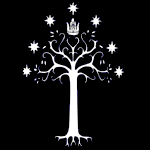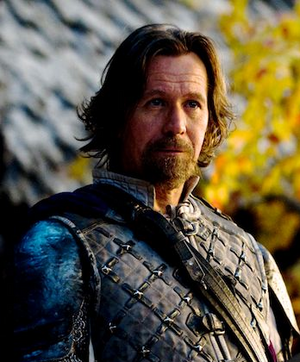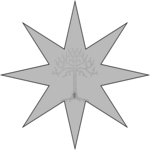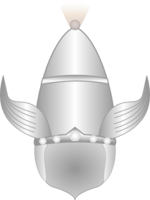High King of Arnor and Gondor
| High King of Arnor and Gondor | |
|---|---|
 Royal standard of the High King | |
| Reunited Kingdom of Arnor and Gondor | |
| Style | His Royal Highness |
| Residence | Dome of the Stars |
| Seat | Osgiliath |
| Precursor | High King of the Dúnedain |
| Formation | T.A. 3019 |
| First holder | Tar Elessar Telcontar |
| Unofficial names | King of the West |
| Deputy | Steward of the King |
The High King of Arnor and Gondor (Quenya: Arantar; Sindarin and Westron: Aran, Adûnaic: Âru) is the Monarch of the Reunited Kingdom of Arnor and Gondor. He is the head of the royal house of the West, the House of Telcontar.
The High King of Arnor and Gondor is the Kings of all Dúnedain and one of the few rulers still of Númenorean descent. Elendil was the leader of the Elendili, those who survived the Downfall.
History
There have been five High-Kings of Arnor and Gondor, two before the sundering of the two Kingdoms and three after the reunification. The two High Kings before the long sundering of both Arnor and Gondor were Elendil the Tall and his son Isildur. After the death of Isildur in T.A. 2, his son Valandil succeeded him as King of Arnor, while his brother Anárion's son Meneldil succeeded him as King of Gondor.
Valandil never attempted to assert power over Gondor, and thus Isildur is counted as the last High King of both Realms before Aragorn II Elessar Telcontar, but the descendants of Valandil continued to use the title High King of Arnor. Later, after the death of Ondoher of Gondor, Arvedui of Arthedain claimed the Kingship over Gondor as the rightful heir of Isildur, but the Council of Gondor, influenced by Steward Pelendur refused Arvedui's claim, saying that Isildur forsook the Kingdom to Meneldil son of Anarion, and that only the heirs of Anarion could be King of Gondor. Arvedui would become the last King of Arnor, and his descendants, the Chieftains of the Dúnedain never attempted to claim the throne of Gondor, nor the High Kingship.
Only at the beginning of the Fourth Age, the two kingdoms came under one ruler again as the Reunited Kingdom under Elessar Telcontar and, later in the Fourth Age, under Elessar Telcontar's son, Tar Eldarion. Tar Eldarion inherited his Kingdom in a manner that recalled the ancient traditions of Númenor: his father Aragorn Elessar gave him the tokens of his rule, and then gave up his life willingly, as his mighty ancestors had done thousands of years before. The new King's mother Arwen left him to rule alone, passing away to the now-empty land of Lórien, where her long life also came to an end.
The incumbent High King, Tar Arfalor I Eldarien, is the Eldarion's eldest son.
High Kingship
High Kingship is a metaphysical concept that is metemsomatised in the presence of charismatic beings, who, because of an innate superiority, compared to the simple human condition, embody the living and effective presence of a force from above within the temporal order. However, High Kings exercise a political authority that does not derive from naturalistic qualities such as force, violence, or from political qualities such as political intelligence or wisdom, skill and ruthlessness. Instead, the authority exercised by the High King is identified as an authority of metaphysical character, which derives its autonomy from the individual dignity and its direct connection with Eru Ilúvatar trough the Valar.
The High King has the power and authority to define doctrines and condemn errors, to promulgate and abrogate laws, to act as a judge in all matters, to decree and inflict penalties, to appoint and remove. Since such power comes from Eru Ilúvatar himself, it is limited by natural law and divine law, which are the expressions of the eternal and immutable truth and goodness that come from Eru Ilúvatar.
The High King is sovereign in the three areas: religious, military and civil. The High King is therefore considered the possessor of a virile and overflowing energy, that is, the energy proper to the royal aura of the sovereign, which is rendered in Quenya as Sirilla i Vëanírë.
The High King presides over an organized State and he is its hearth. The decisions to exercise sovereign powers are directly exercised by the monarch, possibly assisted by ministers or officers of the Crown, or other bodies. Legislative power is directly exercised by the High King, with the advice and counsel of the Councils, within the scopes of promoting justice and combating evil. Executive power is exercised by High King's ministers and officials, as well as by some nobles, in the King's name. Judicial power is vested in the various judiciaries of the Reunited Kingdom.
High Kingship in the Reunited Kingdom of Arnor and Gondor has its traditional dimension and performs a number of functions. The way of realization is an active, dry, heroic way, free from mystical crumbling.
Pathred Polod
Pathred Polod is a Gondorian Sindarin term employed by legal scholar to describe the jurisdictional power of the High King. In the thirteenth century of the Third Age, the legal theorists used the term Pathred Polod to characterize the power of the King of Gondor within the Kingdom, or, more rarely, the hypotetical Isildur's successor's prerogative over all the Faithful. However, during the thirteenth century the King's Pathred Polod expanded as the government became increasingly centralized, and the King's presence made itself felt every day in legislation, judicial appeals, and finance.
Although Pathred Polod had been used in legal reasoning since the time of King Ostoher (T.A. 411 - 492), King Atanatar II (T.A. 1149 - 1226) was the first King to use the term regularly as a description of royal governmental power. King Atanatar II underlined the position of the King as being "above the law and "ordinary judge of all". Essentially, the King was the highest judge in Gondor. His decisions were absolute and could not be abrogated by inferior members of the ecclesiastical hierarchy. However, the King may dispense from the law and interprete the law only fonly for the purpose of serving its own purpose and never to subvert it.
Garaldor described fullness of power as a necessary tool for the work of the government to be speeded up, delays shortened, litigation reduced while, at the same time, he believed it was a power to be used with great caution, as a power "for the purpose of edification and not for destruction".
Functions
The High King, also styled King of all Dunedains and King of the West, fulfills three roles: high priest of the veneration of Valar and of Eru Iluvatar and, therefore, Dùnedains' supreme and chief jurist, ruler of the Reunited Kingdom and commander and leader of the hosts of the Kingdom and, finally, healer and guarantor of prosperity.
The West is a monarchy that unites spiritual and secular leadership - in which Eru and the Valar choose the High King, and the High King represents God to his peoples. The authority of the High King is absolute, except that he must not go against the will of the Valar and of Eru.
Priestly function
The first and foremost of these is the priestly function: to act as the Valar's chosen mediator between Eru Ilúvatar and the people by presiding over the annual rituals. Strictly linked to the priestly role, the High King's second traditional role is as Dùnedains' chief jurist. He serves as the upholder, arbitrator, and executor of the Laws of Númenor. While this function extends well beyond the performance of ritual stipulations, it is nevertheless imbued with religious authority; for the monarch possesses the power to bind oaths by the names of Eru Ilúvatar and the Valar, and so to bless those who fulfill their word and to curse oath breakers.
Juridical function
In his juridical role, the High King has the task to enact new laws as need may arose. The High King's sacred right of command grants him both military powers as well as qualified him to pronounce legal judgment in all cases as the chief justice of the West. He has supreme authority in all cases brought before him, both civil and criminal. This makes the High King supreme in times of both war and peace. To assist the High King, a council advises him during all trials, but this council has no power to control the High King's decisions.
In the West, the justice emanates from the High King and is administered in his name by the judges he institutes. The basic assumption is the subjection of the judge to the High King before the law; according to the official doctrine, the acts of the High King, sometimes justified by the protection of a superior form of justice, above and beyond the ordinary jurisdiction given to the judges, are fully admissible and foreseen.
Military and government function
Beyond being the supreme jurist, the High King also is the actual supreme ruler of the realm, as well as the supreme leader of his hosts at war. The third duty of the monarch is the governance of the Kingdoms in times of peace, and the activity of healing and of guaranteeing prosperity (provided the communion between Eru Iluvatar and Valar and the people is respected). These functions are much less rigid than the other two roles, in part due to the strength of the traditional aristocracy.
The High King is invested with the supreme military, executive, and judicial authority through the use of sacred right to command. The sacred right of command is held for life. As being the sole owner of the sacred right of command, the High King possesses ultimate executive power and unchecked military authority as the commander-in-chief of all Italy's military. His executive power and his sole sacred right of command allows him to issue decrees with the force of law. Another power of the High King is the power to either appoint or nominate officials to offices.
Ultimate ruler
The High King retains full control of the bureaucracy and the army, and every province (save for two exceptions) is ruled by officials appointed by the High King and recallable at will. There are great landowning families, but their wealth and prestige does not automatically mean high political office. However, the great landowners tend to monopolise these positions, because they can afford to give their sons the advanced education required for a career in high public service; but there was always some room for a talented parvenu, and the High King always retains the authority to sack his generals and banish them to their private estates.
Royal infallibility
Royal infallibility is a fundamental tenet of the Númenorean, Gondorian and Western conceptions of royalty which states that, in virtue of the promise of Manwe to Elros, the High King when appealing to his highest authority is preserved from the possibility of error on doctrine "initially given to Elros and handed down in tradition". This doctrine was defined solemnly first by King Elendur of Arnor in T.A. 659 and on a second occasion by King Araval of Arthedain in T.A. 1870.
The infallible teachings of the High King are part of the Royal Doctrine established by Tar Eldarion, which also consists of the Traditions passed down by Valar and the ordinary and universal magisterium.
The doctrine of infallibility relies on the cornerstone of High King's supremacy over all other lords and powers, and his authority as the ruling agent who decides what is truth and justice accepted as formal beliefs in the assembly of the Faithful. Since the Royal Rescript on Peace of the Faithful of T.A. 1870, the only example of an Infallible Decree took place in Fo.A. 195, when Tar Eldarion asserted the duty of Men to protect remaining Elves. In such case the High King checked with sages and scholars that this was in accordance to the Tradition before proceeding to a formal definition. According to the teaching of the Tradition, the conditions required for an infallible royal teaching are as follows:
- the High King, alone or with the # us of the sages and the wises,
- speaks when, in the discharge of his office as shepherd and teacher of all Faithful, he defines a doctrine
- concerning faith or morals
- to be held by all Good Men.
The charism of Royal infallibility must be properly discerned, though only by lords, sages and wises conveniently assembled. Any doctrines defined must be conformable with traditions and Truth.
Privileges of Elendil
The Privileges of Elendil are two distinct sets of Royal Prerogatives originating from edicts issued by King Celebrindor of Arthedain and by King Hyarmnendacil I of Gondor. In T.A. 1075, Tar Hyarmendacil I issued a proclamation known as "Privileges of Anárion", consisting of an enumeration of privileges of the King of Gondor in his capacity of lord of the Faithful. One hundred years later, in T.A. 1180, King Celebrindor of Arthedain issued the Privileges of Isildur, mirroring the claim of Tar Hyarmendacil I, in order to reassert the claim of seniority over Rhudaur and Cardolan. In Fo.A. 121, Tar Eldarion issued the proclamation of the Privileges of Elendil, combining the two previous Privileges in a new catalog, this time named after Elendil.
Privileges formerly known as Privileges of Islidur
- The Kingdom of the West was founded solely by Elendil.
- The High King is the only one by right called the Lord of the Faithful.
- The High King alone can depose or resettle lords.
- In any council, legates of the High Kings, although junior in rank, have greater authority than that of the lords, and may issue a deposition sentence against them.
- According to the needs of the moment, it is only lawful for the High King to make new laws, gather new councils and administer the West.
- The High King alone can use royal signs.
- The High King is allowed to lay down the subjugated principles.
- The High King is allowed to transfer his vassals, his ministers and his legates as needed.
Privileges formerly known as Privileges of Anárion
- Sentences of the High King cannot be reformed by anyone; on the contrary, he can reform any sentence passed by others.
- The High King cannot be judged by anyone.
- Nobody can condemn anyone who appealed to the High King.
- All major causes must be brought before the High King.
- At command of the High King and with His consent, his vassals are entitled to file charges.
New Privileges
- Only to the High King must all princes submit.
- The High King can release the subjects of unfair princes from faithfulness and loyalty.
Crown Jewels of the Reunited Kingdom
The Crown Jewels of the Reunited Kingdom are royal objects and heirlooms, which include the regalia and vestments worn by Numenorean, Gondorian and Arnorian kings and queens. Symbols of centuries of Monarchy, the objects denote the High King's roles as head of state, high priest of the One, and head of the Western armies.
Elendimir
The Star of Elendil (Sindarin: Elendilmir) is the royal insignia f the Kingdom of Arnor, hence the names of Star of the North Kingdom and of Star of the North. Currently, there are two jewels named Elendimir.
The first and noblest Elendimir dates back to the early centuries of Númenor, and belonged to Silmariën, the daughter of King Tar-Elendil. From her, it passed to her descendants the Lords of Andúnië. The last Lord was Amandil, whose son Elendil escaped the Downfall of Númenor and became High King of the Dúnedain in Middle-earth. He wore the Star of Elendil on his brow in place of a crown, as did his son Isildur after him. In early years of the Fourth Age, High King Elessar reopened Orthanc and found the original Elendimir. The original Elendilmir was lost with Isildur, and so a copy was made by the elven smiths of Rivendell for his son Valandil. This second Star of Elendil became the royal symbol of the North-kingdom along with the Sceptre of Annúminas.
Nowadays the Second Elendimir, as it is called, is the ordinary head insignia of Arnor, while on high days and special ceremonies the First Elendimir, which is a jewel of much greater power, is worn.
Sceptre of Annúminas
The Sceptre of Annúminas is a silver rod, originally the symbol of office of the Lords of Andúnië in Númenor. It has survived the Downfall, and was held by the Kings of Arnor while that realm lasted. After the division of the North-kingdom, it was handed down through the generations of the Kings of Arthedain until the death of the last king, Arvedui, in T.A. 1975. After that the sceptre was kept in Rivendell. In 2951, when Aragorn was twenty years old, Elrond gave him the other heirlooms of the House of Elendil, but he withheld the Sceptre saying that Aragorn had yet to earn it. After the War of the Ring, when Elrond arrived in Minas Tirith with his daughter Arwen, he handed the sceptre to Aragorn, who had been crowned as king Elessar.[3] In Fo.A. 120, laying in his deathbed the King gave the sceptre into the hands of his son, Eldarion.
After 153 years, Tar Eldarion passed the rulership of the Reunited Kingdom to his son Tar Arfalor I Eldarien, the current High King, in Fo.A. 273, solemnly giving him the Sceptre of Annúminas.
Crown of Gondor
The Crown of Gondor, also called the Winged Crown and the crown of Elendil, is the ceremonial headgear of the High King Kings of Gondor and Arnor, and is used as a symbol of the Kingship. The current Crown is a tall, jeweled and winged helm, all white, with wings resembling those of a sea-bird wrought of pearl and silver. Seven gems of adamant are set in the circlet. On its summit is a jewel, the light of which goes up like a flame to represent Anarion. On 1 May T.A. 3019 Aragorn II Telcontar came forward to receive the crown. In the year Fo.A. 120 Tar Eldarion received the Crown according the ancient tradition.[1]
In Fo.A. 273 Tar Arfalor I Eldarien, also received the crown from his father's hands, who died soon afterwards.
Royal robes
The distinctive garments of the High King are clothes for special occasions, such as the coronation. The current garments aree based on those worn by King of Gondor Eärnil II, in late Third Age. In T.A. 3019, on occasion of his coronation, High King Elessar wore a simple black chainmail and a silver belt.
In following years, when the circumstances dictated a formal or solemn dress, Elessar wore a long black tunic to his knees, embroidered with the White Tree, the seven stars of Elendil (with the fourth star of a larger dimension to represent Arnor), and the Crown of Anárion (to represent Gondor). The cloak was closed by the Elven gem.
In Fo.A. 119 Tar Elessar and Prince Eldarion conducted extensive research in oder to devise a more solemn clothing to be used for the latter one's coronation ceremony. The following year, Eldarion wore a black tunic to half of the calf, with a silver belt. The tunic was embroidered with seven stars and the White Tree, the Crown of Gondor and the Star of Elendil being physically worn by the High King.
In Fo.A. 273 Eldarien used the same clothing of his father Tar Eldarion, adding a black pallium, consisting of a long strip, dropping down straight in front to just above the waist, and with the portion behind pulled round to the front and hung over the left arm.
Royal Standard
The Royal Standard of the High King is a flag flown by the High Kings. The flag is a square version of the flag of the reunited kingdom, featuring the Winged Crown of Anarion, the White Tree of Isildur and the Seven Stars of Elendil. The heir to the throne flies a similar flag, with a coloured disc with his or her own initials in the lower part of the standard.
The Royal Standard of the High King is flown when the High King is in residence in one of the royal palaces and his carriage or ship, as well as before him when on horse or on foot. It may be flown on any building, official or private, during a visit by the High King. The only place that may fly a Royal Standard, even without the presence of the Sovereign, is the Dome of the Stars, in Osgiliath.
The Royal Standard is flown at royal residences only when the High King is present. Unlike the flag of the Reunited Kingdom, the Royal Standard is never flown at half-mast, even after the death of the previous High King, as there is always a sovereign on the throne.
Crown Prince
Crown Prince (Sindarin: Vaernil) is the title of the heir to the High Kingship of Arnor and Gondor. Normally, but not necessarily, it is conferred on the reigning monarch's eldest son. The Crown Prince often assists the King in the performance of his duties; in line with Dúnadan and Núenorean traditions, the King's heir is entrusted of administration and government roles in order to prepare him (or her) to the heavy burden of the full-fledged rule. The current Vaernil is Prince Iauthor.
The title Crown Prince is given only to the heir apparent—somebody who cannot be displaced in the succession to the throne by any future birth. Since the title of Crown Prince is not automatic, there have been times when it was held by no one.
Royal Court
The Royal Court is the residence and retinue of the High King, and forms the heart of the High King's activities across the Reunited Kingdom, as well as providing for the needs of the Sovereign and his relations.
The Royal Court is divided into two branches: the Congregation of the Cult, which provides assistance to the High King in his functions as spiritual leader of the Reunited Kingdom, especially in religious ceremonies, and the Royal Household, which assists the High King in his temporal function, as well as in the performance of daily activities.
Overseer of the House of the King
The Overseer of the house is an important official at the royal court for he is the main person in charge of the estates supplying the palace and the royal residence with food. The office is quadruple: an Overseer of the House of the King exists for Minas Anor, Osgiliath, Fornost Erain and Annúminas.



